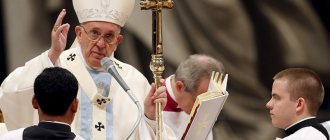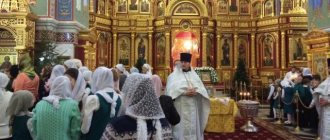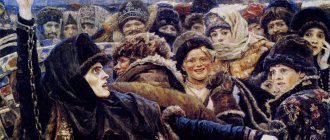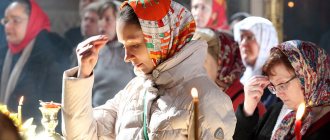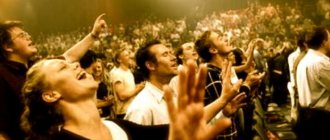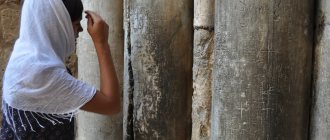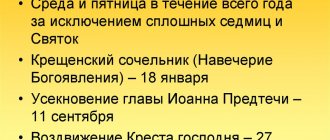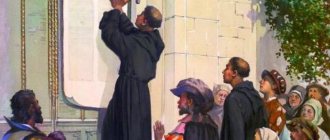This article will focus on what Catholicism is and who Catholics are. This direction is considered one of the branches of Christianity, formed due to a large schism in this religion, which occurred in 1054.
Who are Catholics? Catholicism is in many ways similar to Orthodoxy, but there are also differences. The Catholic religion differs from other movements in Christianity in its religious teachings and cult rituals. Catholicism added new dogmas to the Creed.
Spreading
Catholicism is widespread in Western European (France, Spain, Belgium, Portugal, Italy) and Eastern European (Poland, Slovakia, Czech Republic, Hungary, partly Latvia and Lithuania) countries, as well as in the countries of South America, where it is professed by the vast majority of the population. There are also Catholics in Asia and Africa, but the influence of the Catholic religion is insignificant here. Catholics in Russia are a minority compared to Orthodox Christians. There are about 700 thousand of them. Catholics in Ukraine are more numerous. There are about 5 million people.
Spread of Christianity
Christian churches and non-church organizations make significant efforts to spread Christianity to non-Christians. At the same time, a distinction is made between internal mission (service in the country of residence) and foreign mission (service outside the country of residence). According to some estimates, up to 12 million Christians serve in various national (domestic) missions. Another 400 thousand Christians serve as foreign missionaries; Christian missionaries operate in all countries of the world[85]. Foreign missionaries are supported by 5 thousand international missionary agencies. The annual budget of such agencies is $45 billion (2015)[13].
Approximately three-quarters of all Christian foreign missionaries were sent by 10 countries[85]:
| № | A country | Number of missionaries sent |
| 1 | USA | 127 000 |
| 2 | Brazil | 34 000 |
| 3 | France | 21 000 |
| 4 | Spain | 21 000 |
| 5 | Italy | 20 000 |
| 6 | The Republic of Korea | 20 000 |
| 7 | Great Britain | 15 000 |
| 8 | Germany | 14 000 |
| 9 | India | 10 000 |
| 10 | Canada | 8 500 |
The ideological basis for the missionary activity of Christians is the so-called. The Great Commission of Christ recorded in the Gospel. There, in the Gospel, Christ states: “This Gospel of the Kingdom will be preached throughout the whole world as a testimony to all nations; and then the end will come” (Matthew 24:14). That. the fulfillment of the “Great Commission” is associated with certain eschatological expectations and is a sign of the end of the world. In this regard, a number of Christian research centers pay close attention to statistics on the spread of Christianity. Nations and individuals to whom the teachings of Christ have never been preached are called “not evangelized” (or “not reached with the Gospel”).
Christians have achieved significant success in fulfilling the “Great Commission” only in the last two centuries. If in 1800 three quarters of the world's population (75%) were not familiar with the Christian faith, then by 1900 their share had dropped to 54%[24]. By the middle of the 20th century, for the first time in the history of Christianity, the share of those “not reached by the Gospel” dropped below 50%. The process of evangelization continues: by 1970, 45% of the world's inhabitants were not familiar with the Christian faith; in 2000, their share dropped to 30%[24]. There are currently (2015) 2.14 billion people in the world to whom the gospel has never been preached; they make up 29.3% of the world population[13].
Name
The word "Catholicism" is of Greek origin and translated means universality or universality. In the modern understanding, this term refers to the Western branch of Christianity, which adheres to the apostolic traditions. Apparently, the church was understood as something universal and universal. Ignatius of Antioch spoke about this in 115. The term "Catholicism" was officially introduced at the first Council of Constantinople (381). The Christian Church was recognized as one, holy, catholic and apostolic.
Geography of Christianity
Christianity by parts of the world
The table shows the number of Christians by part of the world (2011[70]). Christians in Russia are classified as part of Europe.
| Part of the world | Number of Christians |
| Europe | 558 824 000 |
| Latin America | 542 670 000 |
| Africa | 474 836 000 |
| Asia | 354 254 000 |
| North America | 231 032 000 |
| Oceania | 23 975 000 |
Christianity by country
Christianity is represented in all 238 countries and territories of the world. The most widespread (by number of countries of presence) Christian denominations are:
| № | Denomination or direction | Countries | Year | Source | Note |
| — | Pentecostals/Charismatics/Neo-Pentecostals | 238 | 2000 | [71][72] | |
| — | Non-denominational Christians | 237 | 2000 | [71] | |
| 1. | Catholics | 235 | 2000 | [71] | including Catholics of the Latin rite - 229 countries[15] |
| — | Charismatic movement | 235 | 2000 | [72] | including charismatic Catholics - 234 countries |
| — | Protestants (all) | 233 | 2000 | [71] | |
| 2. | Pentecostals | 225 | 2000 | [72] | including Assemblies of God - 213 countries[73] |
| 3. | Neo-Pentecostals | 225 | 2000 | [72] | |
| — | Marginal Christians (all) | 215 | 2000 | [71] | |
| 4. | Jehovah witnesses | 212 | 1995 | [15] | |
| 5. | Adventists | 199 | 1995 | [15] | according to own data - 208 countries (2011)[74] |
| 6. | Anglicans | 166 | 2000 | [71] | |
| 7. | Baptists | 163 | 1995 | [15] | including the Baptist World Union - 121 countries[75] |
| 8. | New Apostolic Church | 149 | 1995 | [15] | according to own data - 190 countries (2010)[76] |
| 9. | Reformed and Presbyterian | 141 | 1995 | [15] | |
| 10. | Orthodox and believers of pre-Chalcedonian churches | 135 | 2000 | [71] | including the Russian Orthodox Church - 42 countries[77] |
| 11. | Lutherans | 122 | 1995 | [15] | |
| 12. | Methodists | 117 | 1995 | [15] | |
| 13. | Plymouth Brothers | 113 | 1995 | [15] | |
| 14. | Mormons | 102 | 1995 | [15] | according to own data - 177 countries (2013)[78] |
In 158 countries around the world, Christians make up the majority of the population (more than 50 percent)[38].
Nearly half of all Christians live in 10 countries (Pew Research Center, 2010[79]):
| № | A country | Number of Christians | Predominant direction |
| 1 | USA | 246 790 000 | Protestantism |
| 2 | Brazil | 175 770 000 | Catholicism |
| 3 | Mexico | 107 780 000 | Catholicism |
| 4 | Russia | 105 220 000 | Orthodoxy |
| 5 | Philippines | 86 790 000 | Catholicism |
| 6 | Nigeria | 80 510 000 | Protestantism |
| 7 | China | 67 070 000 | Protestantism |
| 8 | DRC | 63 150 000 | Catholicism |
| 9 | Germany | 58 240 000 | Protestantism, Catholicism |
| 10 | Ethiopia | 52 580 000 | Ancient Eastern churches |
In the above data from the Pew Research Center, noteworthy is the very cautious estimate of the number of Chinese Christians (67 million) and Indian Christians (31.85 million; India was not included in the list).
Back in 2001, the publication “Operation Peace” by the British strategist-missiologist Patrick Jonestown counted 91.5 million Christians in China[80]. In 2007, according to the World Christian Database, there were already 111 million followers of Christ in China[81]. Finally, in 2010, according to J. G. Melton's Encyclopedia of Religions, there were 115 million Christians in China[82]. Taking into account the latest data, China is one of the three largest Christian countries (in terms of the number of Christians, second only to the USA and Brazil).
The number of Christians in India is also debatable. A number of publications include India in the list of the 10 largest countries by the number of Christians (instead of Ethiopia). At the same time, the number of Christians in this country is estimated at 57 million[83], 58 million[82] and even 71 million[84] believers (data for 2010).
Origin of Catholicism
The term “church” began to appear in written sources (letters of Clement of Rome, Ignatius of Antioch, Polycarp of Smyrna) from the second century. This word was synonymous with municipality. At the turn of the second and third centuries, Irenaeus of Lyons applied the word "church" to Christianity in general. For individual (regional, local) Christian communities it was used with the corresponding adjective (for example, the Church of Alexandria).
In the second century, Christian society was divided into laity and clergy. In turn, the latter were divided into bishops, priests and deacons. It remains unclear how governance was carried out in the communities - collegially or individually. Some experts believe that the government was initially democratic, but over time it became monarchical. The clergy was governed by a Spiritual Council headed by a bishop. This theory is supported by the letters of Ignatius of Antioch, in which he mentions bishops as leaders of Christian municipalities in Syria and Asia Minor. Over time, the Spiritual Council became merely an advisory body. But only the bishop had real power in a particular province.
In the second century, the desire to preserve apostolic traditions contributed to the emergence of church hierarchy and structure. The Church had to protect the faith, dogmas and canons of the Holy Scriptures. All this, as well as the influence of the syncretism of the Hellenistic religion, led to the formation of Catholicism in its ancient form.
The final formation of Catholicism
After the division of Christianity in 1054 into western and eastern branches, they began to be called Catholic and Orthodox. After the Reformation of the sixteenth century, the word “Roman” began to be added more and more often to the term “Catholic” in everyday use. From the point of view of religious studies, the concept of "Catholicism" covers many Christian communities that adhere to the same doctrine as the Catholic Church and are subject to the authority of the Pope. There are also Uniate and Eastern Catholic churches. As a rule, they left the authority of the Patriarch of Constantinople and became subordinate to the Pope, but retained their dogmas and rituals. Examples are the Greek Catholics, the Byzantine Catholic Church and others.
History of Catholicism
As a separate movement of Christianity, it separated back in 1054.
This happened after the “Great Schism,” when the Pope and the Patriarch anathematized each other. The followers also divided into two “camps” and since then, Catholicism has been considered a separate religious movement.
Like the Orthodox, they have their own symbols and attributes that symbolize their faith.
Catholicism is considered one of the most widespread religions on the planet. In Europe, most countries are controlled and the church has the strongest influence on people's lives. For example, Poland, Belgium, Italy and others. The American continent has the largest number of Catholics.
Basic tenets and postulates
To understand who Catholics are, you need to pay attention to the basic tenets of their faith. The main dogma of Catholicism, which distinguishes it from other areas of Christianity, is the thesis that the Pope is infallible. However, there are many known cases when Popes, in the struggle for power and influence, entered into dishonest alliances with large feudal lords and kings, were obsessed with the thirst for profit and constantly increased their wealth, and also interfered in politics.
The next postulate of Catholicism is the dogma of purgatory, approved in 1439 at the Council of Florence. This teaching is based on the fact that the human soul after death goes to purgatory, which is an intermediate level between hell and heaven. There she can be cleansed of her sins through various tests. Relatives and friends of the deceased can help his soul cope with trials through prayers and donations. It follows from this that a person’s fate in the afterlife depends not only on the righteousness of his life, but also on the financial well-being of his loved ones.
An important postulate of Catholicism is the thesis about the exclusive status of the clergy. According to him, without resorting to the services of the clergy, a person cannot independently earn God's mercy. A Catholic priest has serious advantages and privileges compared to the ordinary flock. According to the Catholic religion, only the clergy has the right to read the Bible - this is their exclusive right. This is prohibited for other believers. Only publications written in Latin are considered canonical.
Catholic dogmatics determines the need for systematic confession of believers before the clergy. Everyone is obliged to have his own confessor and constantly report to him about his own thoughts and actions. Without systematic confession, the salvation of the soul is impossible. This condition allows the Catholic clergy to penetrate deeply into the personal lives of their flock and control a person's every move. Constant confession allows the church to have a serious influence on society, and especially on women.
Meaning
As for the Orthodox, for Catholics the cross signifies liberation and a symbol of the victory of good over evil. Can be interpreted as an attribute of an eternal afterlife. The cross also symbolizes hope and faith - this is its main purpose.
A person receives it as a sign that he is committed to a particular church.
There is also the cross of St. Peter, which can symbolize faith in Christianity. It does not at all symbolize Satanism or blasphemy, but is one of the varieties of the Catholic cross. It is worth noting that this is a regular Latin inverted cross. You can find many different crosses that are used not only by Catholics, but also by Orthodox Christians.
Each variety symbolizes involvement in the church and is also highly revered by the Christian Church.
It is worth noting that for Catholics the ordinary cross and the Papal cross differ in the number of ends. The papal represents a triple government, as the highest order of priest.
He is higher than everyone else because he is more committed to the Lord and can send his prayers directly.
Catholic sacraments
The main task of the Catholic Church (the community of believers as a whole) is to preach Christ to the world. The sacraments are considered visible signs of God's invisible grace. Essentially, these are actions established by Jesus Christ that must be performed for the good and salvation of the soul. There are seven sacraments in Catholicism:
- baptism;
- anointing (confirmation);
- Eucharist, or communion (Catholics take their first communion at the age of 7-10 years);
- sacrament of repentance and reconciliation (confession);
- anointing;
- sacrament of the priesthood (ordination);
- sacrament of marriage.
According to some experts and researchers, the roots of the sacraments of Christianity go back to the pagan mysteries. However, this point of view is actively criticized by theologians. According to the latter, in the first centuries A.D. e. The pagans borrowed some rituals from Christianity.
What is the Catholic Church
Other periods of the liturgical year are united under the general name “ordinary time.”
Church holidays are divided into three ranks: “memory” (of a saint or event), “holiday” and “triumph”.
The main holidays of the Catholic liturgical year are Easter and Christmas .
Both of these holidays have octaves , i.e. are celebrated within eight days after the date of the holiday. The apogee of the annual liturgical cycle is the Easter Triduum . This is the name of the three days preceding Easter Sunday - Maundy Thursday, Good Friday and Holy Saturday.
For clergy and monastics, a breviary , i.e. daily reading of prayers. Lay people perform the breviary at their own discretion, according to their personal daily routine.
Interior of Barcelona Cathedral.
The Catholic rite is characterized by great solemnity of worship, accompanied by the singing of psalms.
In large churches, singing is usually accompanied by organ music. Believers usually sit when reading prayers - in Catholic churches, unlike Orthodox churches, there are special benches for this. Great importance is attached to the decoration of the temple: paintings and sculptures of the Mother of God, the Crucifixion, saints, the fire of lamps reflected in the expensive frames of icons and paintings, the smell of incense, the sounds of the organ and even the appropriate intonation of the priest’s voice - everything should influence the imagination and feelings of believers.
The excellent acoustics of large churches is of considerable importance.
In addition to liturgical services, so-called passion services : Stations of the Cross, adoration of the Holy Gifts, prayer processions, etc.
The Catholic clergy includes only men.
White clergy are considered to be priests serving in churches. Monks are considered black clergy. In the clergy there are three degrees of priesthood: deacon, priest (priest) and bishop (bishop).
Non-clergy ministers of the church - acolytes, readers, singers and other support staff do not belong to the clergy.
The hierarchy of clergy by position is quite long: cardinal - archbishop - primate - metropolitan - prelate - abbot - rector, etc.
The Catholic Church (like the Orthodox Church) recognizes seven sacraments: baptism, marriage (marriage), confirmation (confirmation), Eucharist (comunion), confession, unction and priesthood.
There are some differences in the administration of these sacraments between Catholics and Orthodox Christians.
For example, baptism in the Catholic Church is performed not by immersing a child in water, but by pouring it over it. Confirmation (confirmation) is not performed simultaneously with the baptism of the child, but upon reaching the age of 8 years. Confirmation is performed by a bishop and only in exceptional cases by a priest.
Communion (Eucharist) for the laity is performed under one form (i.e.
only bread), or under two types (i.e., both bread and wine) - both are considered full communion. For the priesthood, the sacrament is celebrated under only two types. Until the Second Vatican Council (1962-1965) this was the privilege of the clergy.
For communion, Catholics use unleavened bread (the so-called host), while Orthodox churches use leavened bread. Bread and wine in Christian rituals symbolize the body and blood of Christ, respectively. That is why such great importance is attached to the quality, or rather, the technology of making bread.
In the XII-XIII centuries, some Christian sects declared the death penalty for those who did not believe the words of the Holy Scriptures that Christ was visiting under the guise of bread.
The following distinctive features of the Catholic rite can be noted: Catholics cross themselves with five fingers from left to right (five fingers mean the five wounds of Christ); there are differences from Orthodoxy in the attire of the clergy and even in appearance (no beard), etc.
It would seem that Christianity assumes the same symbols, but despite this, the Catholic cross and Orthodox crosses have a significant difference.
The attributes of religion are different for each religious movement. In this article you can learn how to identify the Orthodox and Catholic cross.
What is the difference between Catholics and Orthodox Christians?
What Catholicism and Orthodoxy have in common is that in both of these branches of Christianity, the church is a mediator between man and God. Both churches agree that the Bible is the fundamental document and doctrine of Christianity. However, there are many differences and disagreements between Orthodoxy and Catholicism.
Both directions agree that there is one God in three incarnations: Father, Son and Holy Spirit (trinity). But the origin of the latter is interpreted differently (the Filioque problem). The Orthodox profess the “Creed,” which proclaims the procession of the Holy Spirit only “from the Father.” Catholics add “and the Son” to the text, which changes the dogmatic meaning. Greek Catholics and other Eastern Catholic denominations have retained the Orthodox version of the Creed.
Both Catholics and Orthodox understand that there is a difference between the Creator and the creation. However, according to Catholic canons, the world has a material nature. He was created by God out of nothing. There is nothing divine in the material world. While Orthodoxy assumes that the divine creation is the embodiment of God himself, it comes from God, and therefore he is invisibly present in his creations. Orthodoxy believes that you can touch God through contemplation, that is, approach the divine through consciousness. Catholicism does not accept this. Another difference between Catholics and Orthodox Christians is that the former consider it possible to introduce new dogmas. There is also a teaching about the “good deeds and merits” of Catholic saints and the Church. On its basis, the Pope can forgive the sins of his flock and is the vicar of God on Earth. In matters of religion he is considered infallible. This dogma was adopted in 1870.
Structure of the Catholic Church
Faith of the Roman Catholic Church
The doctrine of the Catholic Church is set out in the Nicene-Constantinople Creed and is revealed in the decisions of the first seven Ecumenical Councils, as well as councils held later on the initiative of the Pope.
In the main issues of doctrine, Catholicism has much in common with Orthodoxy, but there are also differences. Here are the main ones. The Roman Catholic Church teaches that there is one eternal God in three persons: God the Father, God the Son (Jesus Christ) and God the Holy Spirit. Catholic dogma is given in the Nicene Creed and described in detail in the Catechism of the Catholic Church. The Catholic faith declares that the Church "...is the continuing presence of Jesus on earth." The Church teaches that salvation exists only in the Catholic Church, but recognizes that the Holy Spirit can use Christian communities to bring people to salvation.
Hierarchy of the Roman Catholic Church
The head of the Church is the Pope.
As in all other historical churches, the priestly hierarchy is clearly separated from the laity, and is divided into three degrees of priesthood:
- bishop;
- priest.
- deacon
The hierarchy of the clergy includes numerous ecclesiastical degrees and offices (see Ecclesiastical degrees and offices in the Roman Catholic Church), as an example:
- cardinal;
- archbishop;
- primate;
- Metropolitan;
- prelate;
- abbot;
There are also the offices of Ordinary, Vicar, and Coadjutor—the latter two offices involving the function of a deputy or assistant, such as a bishop. Members of monastic orders are sometimes called regular (from the Latin regula - rule) clergy, but the majority, appointed by the bishop, are diocesan, or secular. Territorial units can be:
- diocese (diocese);
- archdiocese (archdiocese);
- apostolic administration;
- apostolic prefecture;
- Apostolic Exarchate;
- Apostolic Vicariate;
- Territorial Abbey;
Each territorial unit consists of parishes, which can sometimes be grouped into deaneries. The union of dioceses and archdioceses is called a metropolitanate, the center of which always coincides with the center of the archdiocese. There are also military ordinariates serving military units. Particular Churches in the world, as well as various missions, have the status of “Sui iuris”.
Collegiality in the government of the Church (extra Ecclesiam NULLA salus) is rooted in apostolic times. The Pope exercises administrative authority in accordance with the Code of Canon Law and may consult with the World Synod of Bishops. Diocesial clergy (archbishops, bishops, etc.) act within the framework of ordinary jurisdiction, that is, associated by law with the office. A number of prelates and abbots also have this right, and priests within the limits of their parish and in relation to their parishioners.
Structure of the Catholic Church
The Pope of Rome has the highest, full, immediate, universal and ordinary authority in the Catholic Church. The advisory bodies under the pope are the College of Cardinals and the Synod of Bishops. The administrative apparatus of the Church is called the Roman Curia, which includes congregations, courts and other institutions. The episcopal see of the pope together with the curia form the Holy See, located in the independent state of Vatican City. The Holy See is a subject of international law.
The Universal Catholic Church consists of the Latin Rite Church and the Eastern Catholic Churches, which profess one of the Eastern liturgical rites and have the status of “sui iuris” (their right). In practice, this is expressed in the fact that these churches, while remaining in communion with the Pope and fully sharing Catholic dogma, have their own hierarchical structure and their own canon law. The largest Eastern Catholic churches are headed by a Patriarch or supreme archbishop. Eastern Patriarchs and supreme archbishops are equated to cardinal bishops of the Latin rite and occupy the place immediately behind the pope in the Catholic hierarchy.
The basic distinct territorial unit is the diocese, headed by a bishop. Some important dioceses have historically been called archdioceses. Other types of territorial units are equated to dioceses:
- apostolic vicariate
- apostolic prefecture
- apostolic administration
- military ordinariate
- territorial prelature
- territorial abbey
In the Eastern Catholic Churches, there are also exarchates.
Several dioceses (and archdioceses) may constitute a metropolitanate or an ecclesiastical province. The center of the metropolitanate necessarily coincides with the center of the archdiocese, thus the metropolitan in the Catholic Church is necessarily an archbishop. In some countries (Italy, USA, etc.) metropolises are united into ecclesiastical regions. The bishops of most countries are united in a conference of bishops, which has great powers in organizing the church life of the country.
Dioceses consist of parishes, which are headed by parish priests, subordinate to the bishop. The rector in the parish may be assisted by other priests, called vicars. Sometimes nearby parishes unite into deaneries.
A special role in the Catholic Church is played by the so-called institutions of consecrated life, that is, monastic orders and congregations; as well as the Society of Apostolic Life. Institutes of consecrated life have their own statutes (approved by the pope); their territorial organization does not always correspond to the diocesan structure of the church. Local units of monastic orders and congregations are sometimes subordinate to local diocesan bishops and sometimes directly to the pope. A number of orders and congregations have a single head (General of the Order, Superior General) and a clear hierarchical structure; others are amalgamations of completely autonomous communities.
Differences in rituals. How Catholics are baptized
There are also differences in rituals, the design of churches, etc. Orthodox Christians even perform the prayer procedure not exactly the same way as Catholics pray. Although at first glance it seems that the difference is in some small details. To feel the spiritual difference, it is enough to compare two icons, Catholic and Orthodox. The first one looks more like a beautiful painting. In Orthodoxy, icons are more sacred. Many people are wondering how to properly baptize Catholics and Orthodox Christians? In the first case, they are baptized with two fingers, and in Orthodoxy - with three. In many Eastern Catholic rites, the thumb, index and middle fingers are placed together. How else are Catholics baptized? A less common method is to use an open palm, with the fingers pressed tightly together and the thumb slightly tucked inward. This symbolizes the openness of the soul to the Lord.
Catholic Church Rites
Features of the Catholic Church Rite
Catholic church rites have a number of features that distinguish them from Orthodox and Protestant rites. Priests and bishops of the Latin rite must take a vow of celibacy. In Orthodoxy, only monasticism gives a vow of celibacy.
In the 20th century, the institution of a permanent diacanate was restored; For permanent deacons, celibacy is not required, but such deacons will no longer be able to become priests.
In Eastern Catholic rites, celibacy is only mandatory for bishops.
The most common rite in the Catholic Church is Latin or Roman . Other Western rites are used only within the territory of a particular monastic order or city.
For example, certain differences from the Latin (Roman) rite are found in the Ambrosian (western Lombardy), Braga (Braga in Portugal), and also in the Mozarabic (Toledo in Spain) rites. Eastern rites are used in the worship of Eastern Catholic churches . For example, the Greek Catholic rite is used in the Eastern Catholic churches of Belarus, Slovakia, Hungary, Romania, Ukraine, in the churches of the Rusyns, and also in small quantities among Greeks, Bulgarians, Croats and Russians.
Divine services in the Latin rite until the Second Vatican Council (1962-1965) were traditionally performed in Latin.
Later, services began to be performed in national languages as well. The Liturgy of the Latin Rite or Mass is the main liturgical action in which the sacrament of the Eucharist (communion) is celebrated. The Mass consists of the Liturgy of the Word , the main element of which is the reading of the Bible, and the Eucharistic Liturgy .
The liturgical year begins with Advent , i.e. from the Nativity Fast and is divided into several periods: two fasting periods - Advent and Great Lent , two holiday periods - Christmas and Easter .
Man's destiny
The Catholic Church teaches that people are burdened by original sin (with the exception of the Virgin Mary), that is, every person from birth has a grain of Satan. Therefore, people need the grace of salvation, which can be obtained by living by faith and doing good works. The knowledge of the existence of God is, despite human sinfulness, accessible to the human mind. This means that people are responsible for their actions. Every person is loved by God, but at the end the Last Judgment awaits him. Particularly righteous and godly people are ranked among the Saints (canonized). The church keeps a list of them. The process of canonization is preceded by beatification (beatification). Orthodoxy also has a cult of Saints, but most Protestant movements reject it.
General information
Christianity is the most widespread religion in the world and the only religion whose adherents live in all 232 countries of the world[14] (according to the methodology of the World Christian Encyclopedia (2000) and the Encyclopedia of World Religions (2004) - in all 238 countries of the world[15] [2]). At the beginning of the 21st century, only 116 cities in the world (with a population of more than 50 thousand) did not have a single functioning Christian church[16]. In 2015, there were over 4.3 million Christian local churches and places of worship worldwide[13]. Every year the number of churches increases by 50 thousand.[17] Christian services are attended by 1.5 billion people[18], including 600 million weekly[19].
However, despite its global influence, Christianity is considered the most persecuted religion in the world. The authors of the Blankenburg Proclamation claim that more than 200 million Christians are persecuted for their beliefs[20]. Similar figures are contained in the report of the British intelligence service MI6[21]. The number of those persecuted apparently includes 124 million Christians from 63 countries who are forced to hide their faith (the so-called “crypto-Christians”)[22].
Throughout history, more than 70 million Christians became martyrs, and 45 million of them died in the 20th century[23]. In the 21st century, every year the number of those killed for faith in Christ increases by 100 thousand people[24].
The majority of the world's Christians (64%) live in cities. There are 408 million Christians living in the diaspora (outside their country of origin).[25] The average age of a Christian is 30 years[26]. At the same time, 565 million modern Christians are children under 15 years of age. Life expectancy for a Christian corresponds to the world average of 68 years (2001). According to the Human Development Index, Christians are higher than “non-Christians” (0.73 and 0.58, respectively)[27]. Similarly, Christians have higher literacy rates than non-Christians. 88% of adult Christians and 81% of adult Christian women can read and write (for “non-Christians” the literacy rate is 78% and 60%, respectively)[27].
Indulgences
In Catholicism, an indulgence is the complete or partial release of a person from punishment for his sins, as well as from the corresponding expiatory action imposed on him by the priest. Initially, the basis for receiving an indulgence was the performance of some good deed (for example, a pilgrimage to holy places). Then they became a donation of a certain amount to the church. During the Renaissance, serious and widespread abuses were observed, which consisted of the distribution of indulgences for money. As a result, this sparked the start of protests and a reform movement. In 1567, Pope Pius V banned the issuance of indulgences for money and material resources in general.
Celibacy in Catholicism
Another serious difference between the Orthodox Church and the Catholic Church is that all the clergy of the latter take a vow of celibacy. Catholic clergy do not have the right to marry or have sex at all. All attempts to marry after receiving the diaconate are considered invalid. This rule was announced during the time of Pope Gregory the Great (590-604), and was finally approved only in the 11th century.
The Eastern churches rejected the Catholic version of celibacy at the Council of Trullo. In Catholicism, the vow of celibacy applies to all clergy. Initially, minor church ranks had the right to marry. Married men could be initiated into them. However, Pope Paul VI abolished them, replacing them with the positions of reader and acolyte, which were no longer associated with the status of cleric. He also introduced the institution of deacons for life (those who do not intend to advance further in their church career and become priests). These may include married men.
As an exception, married men who converted to Catholicism from various branches of Protestantism, where they held the ranks of pastors, clergy, etc., can be ordained to the priesthood. However, the Catholic Church does not recognize their priesthood.
Now the obligatory celibacy for all Catholic clergy is the subject of heated debate. In many European countries and the United States, some Catholics believe that mandatory celibacy should be abolished for non-monastic clergy. However, Pope John Paul II did not support such a reform.
Main directions in Christianity
Most Christians (95%) identify with one Christian denomination or another; the remaining 119 million who consider themselves Christians do not belong to any church[14]. Among the latter, a significant number are crypto-Christians who are forced to hide their faith. It should also be noted that approx. 170 million Christians are simultaneously registered in two or more Christian denominations[14]. Among these are many Latin Americans who were baptized in Catholicism, but converted to Protestantism at a conscious age.
Catholicism
Just over half of all Christians (more than 1.2 billion) consider themselves Catholic. At the same time, the vast majority of Catholics are part of the Roman Catholic Church (1.214 billion[31]). This number also includes Catholics of the Eastern rites (17.4 million[32]).
Catholics of the Eastern Rites
| Church | Number of believers | Liturgical rite |
| Ukrainian Greek Catholic Church | 4 345 000 | Byzantine |
| Syro-Malabar Catholic Church | 3 893 000 | East Syriac |
| Maronite Catholic Church | 3 382 000 | Maronite |
| Melkite Greek Catholic Church | 1 652 000 | Byzantine |
| Romanian Greek Catholic Church | 535 000 | Byzantine |
| Ruthenian Greek Catholic Church | 487 000 | Byzantine |
| Armenian Catholic Church | 566 000 | Armenian |
| Chaldean Catholic Church | 536 000 | East Syriac |
| Syro-Malankara Catholic Church | 438 000 | West Syriac |
| Hungarian Catholic Church | 327 000 | Byzantine |
| Slovak Greek Catholic Church | 233 000 | Byzantine |
| Ethiopian/Eritrean Catholic Church | 227 000 | Ethiopian |
| Coptic Catholic Church | 166 000 | Coptic |
| Syriac Catholic Church | 159 000 | West Syriac |
| other | 137 000 |
Other Catholics
At various times, over a dozen groups, conventionally called “non-Roman Catholics,” separated from the Roman Catholic Church. Among non-Roman Catholics, the most prominent groups are Conservative Catholics (6 million)[33] and Old Catholics (0.4 million)[34].
Protestantism
Main directions of Christianity
The second (in terms of the number of believers) direction of Christianity is Protestantism. Currently in the world there are approx. 800 million Protestants[35][36][37]. In 92 countries of the world, Protestantism is the largest denomination of Christianity, including in 49 countries Protestants make up the majority of the population[38]. Protestants usually include:
- historical Protestant churches (Anglicans, Lutherans, Reformed churches);
- Protestant denominations that arose within the framework of post-Reformation movements (Baptists, Methodists, Adventists, Pentecostals);
- parishioners of United Protestant and non-denominational churches;
- believers of independent African movements;
- other denominations (the New Apostolic Church and some others, whose affiliation with Protestantism is a controversial issue).
Major Protestant movements
The number of main Protestant movements (over 4 million parishioners) can be seen in the table:
| # | Name | Number | Note |
| 1 | Pentecostalism | 279 000 000 | [39]; including neo-Pentecostals |
| 2 | Baptistism | 100 000 000 | [40][41]; including a number of movements related to Baptistism |
| 3 | United Churches | 75 000 000 | see below |
| 4 | Anglicanism | 76 000 000 | according to the Anglican Communion - 85 million[42], excluding the United Churches |
| 5 | Lutheranism | 59 000 000 | according to the Lutheran World Federation - 74 million[43], excluding the United Churches |
| 6 | Methodism | 48 000 000 | according to the World Methodist Council - 80 million[44], excluding United and Perfectionist churches |
| 7 | Calvinism | 40 000 000 | according to the World Union of Reformed Churches - 80 million[45], excluding the United Churches and Anglicans |
| 8 | Independent African churches | 30 000 000 | |
| 9 | Adventism | 25 000 000 | [46]; all Adventist denominations, including children |
| 10 | Independent churches of the Catholic tradition | 17 000 000 | New Apostolic Church (10 million[47]), Philippine Independent Church (6 million[48]), etc. |
| 11 | Perfectionism | 13 000 000 | Church of the Nazarene, Christian and Missionary Alliance, etc. |
| 12 | Restorationists | 9 000 000 | Churches of Christ, Disciples of Christ, International Church of Christ, etc. |
| 13 | Anabaptism | 4 000 000 | Mennonites, Amish, Hutterites, Dunkers, etc. |
United Churches
United churches are churches formed by the merger of different Protestant denominations - Lutherans, Anglicans, Reformed, Presbyterians, Methodists, Baptists, Quakers, etc. In most cases, the merger was voluntary, in some cases it was imposed by government authorities (Chinese Christian Council, Church of Christ in Congo). The United Churches number 75 million believers in their ranks, and the process of uniting different Protestant groups continues.
List of large united churches (over 1 million parishioners):
| Church name | Number | Note |
| Evangelical Church of Germany | 23 700 000 | |
| Chinese Christian Council | 23 000 000 | [49][50] |
| Church of South India | 6 000 000 | [44] |
| United Church of Zambia | 4 600 000 | [44] |
| Church of Jesus Christ in Madagascar | 3 500 000 | [51] |
| Church of North India | 2 500 000 | [44] |
| Protestant Church of the Netherlands | 2 100 000 | |
| United Church of Canada | 1 800 000 | [44] |
| Uniting Church in Australia | 1 300 000 | [44] |
| United Church of Papua New Guinea | 1 000 000 | [44] |
Formally, the Church of Christ in the Congo (25.5 million[52]) also belongs to the united churches. The Church is a federation of 64 autonomous Protestant unions, each of which is usually considered separately; data on the number of believers of the constituent parts of the Church of Christ in the Congo are included in the corresponding denominations.
Orthodox and ancient Eastern churches
The third major trend within Christianity conventionally unites believers of the Orthodox and Ancient Eastern churches. This group can be divided into three subgroups: canonical Orthodoxy (180-227 million), other Orthodox groups (17 million) and pre-Chalcedonian churches (70 million).
Autocephalous (canonical) Orthodoxy
By the number of believers, the 15 autocephalous churches are located as follows (together with parishioners of autonomous and self-governing churches):
| Church | According to the encyclopedia “Religions of the World” (2010)[1] | According to the encyclopedia “Peoples and Religions of the World” (1998)[53] | According to the World Christian Encyclopedia (1995)[15] | Website data from St John's Orthodox Church, Colchester[54] | According to the directory “Eastern Christian Churches” (1999)[55] | |
| 1. | Russian Orthodox Church | 90-120 million | 110 000 000 | 114 188 000 | 164 000 000 | 80 000 000 |
| 2. | Romanian Orthodox Church | 18 800 000 | 20 000 000 | 19 271 000 | 18 800 000 | 19 800 000 |
| 3. | Greek Orthodox Church | 9 000 000 | 10 000 000 | — | 10 000 000 | 9 025 000 |
| 4. | Serbian Orthodox Church | 8 000 000 | 9 900 000 | 7 286 000 | 8 000 000 | 8 000 000 |
| 5. | Bulgarian Orthodox Church | 6 350 000 | 6 000 000 | 6 384 000 | 6 500 000 | 8 000 000 |
| 6. | Georgian Orthodox Church | 3 600 000 | 3 300 000 | 2 589 000 | 3 500 000 | 3 500 000 |
| 7. | Constantinople Orthodox Church | 3 500 000 | 3 000 000 | — | 2 800 000 | 3 500 000 |
| 8. | Orthodox Church in America | 1 000 000 | 1 000 000 | 2 030 000 | 100 000 | 1 000 000 |
| 9. | Antiochian Orthodox Church | 750 000 | 800 000 | — | 900 000 | 750 000 |
| 10. | Cypriot Orthodox Church | 654 000 | 500 000 | — | 650 000 | 442 000 |
| 11. | Polish Orthodox Church | 555 000 | 800 000 | 1 021 000 | 600 000 | 570 000 |
| 12. | Albanian Orthodox Church | 400 000 | 300 000 | — | 300 000 | 160 000 |
| 13. | Alexandria Orthodox Church | 250 000 | 700 000 | — | 1 500 000 | 250 000 |
| 14. | Jerusalem Orthodox Church | 200 000 | 130 000 | — | 130 000 | 130 000 |
| 15. | Orthodox Church of the Czech Lands and Slovakia | 75 000 | 100 000 | 72 000 | 110 000 | 55 000 |
Other Orthodox groups
Spread of Orthodoxy in the world
Approximately 17 million Orthodox believers belong to churches and movements that are not recognized by world (canonical) Orthodoxy. Conventionally, they can be divided into:
- Old Orthodox movements (Old Believers of all agreements and interpretations, 2.5 million[56]);
- Old Calendar churches (4 million, more than 30 movements);
- Unrecognized national and independent autocephalies (10 million, 75 movements[15]);
- Reformed Orthodox churches (charismatic, liberal, eschatological and esoteric groups).
Ancient Eastern churches
Currently, the ancient Eastern churches are divided into two different groups:
1) Nestorians who refused to recognize the Third Ecumenical Council and, accordingly, all subsequent Ecumenical Councils. Today the Nestorians are represented by two organizations:
- Assyrian Church of the East - 500 thousand[57].
- Ancient Assyrian Church of the East - 55 thousand[58]
2) Monophysites and Miaphysites, who abandoned the dogmatic definitions of the Fourth Ecumenical Council - the Council of Chalcedon. Therefore they are called pre-Chalcedonian churches. This group includes:
- Armenian-Gregorians: Armenian Apostolic Church - 9.3 million (including the Etchmiadzin Catholicosate - 8 million[59] and the Cilician Catholicosate - 1.3 million[60]);
- Jacobites: Malankara Orthodox Syrian Church - 2 million [61]);
- Independent Jacobite Church of Malabar - 21 thousand[62];
- Syro-Jacobite Orthodox Church - 1.43 million[63];
- Copts, Ethiopians and Eritreans: Coptic Orthodox Church - 12 million[64];
- Eritrean Orthodox Church - 2 million[65];
- Ethiopian Orthodox Church - 39 million[66].
- Reformed Monophysites: Church of St. Thomas - 1.5 million[67]
Marginal Christianity
The fourth direction in Christianity includes groups of para-Christianity that are not connected with each other (33 million believers). These are various groups of Mormonism (15 million), Jehovah's Witnesses and splinter groups from them (16.5 million including children[68]), followers of Christian Science, British Israelites, Christadelphians, Swedenborgians and some others.
Largest Christian churches and denominations
The list includes the largest churches and denominations of all Christian denominations:
| № | Name | Believers | Parishes | Note |
| 1 | Roman Catholic Church (Latin Rite) | 1 197 000 000 | 275 000 | Catholicism |
| 2 | Russian Orthodox Church | 164 000 000 | 30 142 | Orthodoxy |
| 3 | Assemblies of God | 67 500 000 | 366 105 | Protestantism (Pentecostals) |
| 4 | Ethiopian Orthodox Church | 39 000 000 | 40 000 | Ancient Eastern churches |
| — | Church of Christ in the Congo (federation of churches) | 25 500 000 | Protestantism | |
| 5 | Seventh-day Adventists | 25 000 000 | 72 144 | Protestantism (Adventists) |
| 6 | Church of England | 25 000 000 | 16 196 | Protestantism (Anglicans) |
| 7 | Evangelical Church of Germany | 23 700 000 | 15 471 | Protestantism |
| 8 | Chinese Christian Council | 23 000 000 | 50 000 | Protestantism |
| 9 | Anglican Church of Nigeria | 20 000 000 | Protestantism (Anglicans) | |
| 10 | Romanian Orthodox Church | 18 800 000 | 13 527 | Orthodoxy |
| 11 | Jehovah witnesses | 16 500 000 | 115 416 | Para-Christianity |
| 12 | Southern Baptist Convention | 16 200 000 | 45 764 | Protestantism (Baptists) |
| 13 | Church of Jesus Christ of Latter-day Saints | 14 500 000 | 28 000 | Para-Christianity |
| 14 | United Methodist Church (USA) | 12 500 000 | 34 892 | Protestantism (Methodists) |
| 15 | Coptic Orthodox Church | 12 000 000 | Ancient Eastern churches | |
| 16 | Church "China for Christ" | 12 000 000 | Protestantism (Pentecostals) | |
| 17 | Church of Uganda | 11 000 000 | 13 000 | Protestantism (Anglicans) |
| 18 | New Apostolic Church | 10 000 000 | 64 688 | Protestantism |
| 19 | Chinese Evangelical Fellowship | 10 000 000 | Protestantism (Pentecostals) | |
| 20 | Church of God in Christ | 10 000 000 | 15 000 | Protestantism (Pentecostals) |
| 21 | Ukrainian Orthodox Church of the Kyiv Patriarchate | 10 000 000[69] | 4 482 | Orthodoxy (alternative) |
Celibacy in Orthodoxy
In Orthodoxy, clergy can be married if the marriage took place before ordination to the priesthood or deaconship. However, only monks of the minor schema, widowed or celibate priests can become bishops. In the Orthodox Church, a bishop must be a monk. Only archimandrites can be ordained to this rank. Simply celibates and representatives of married white clergy (non-monastics) cannot become bishops. Sometimes, as an exception, episcopal ordination is possible for representatives of these categories. However, before this they must accept the minor monastic schema and receive the rank of archimandrite.
Inquisition
To the question of who the Catholics of the medieval period were, you can get an idea by familiarizing yourself with the activities of such a church body as the Inquisition. It was a judicial institution of the Catholic Church, which was intended to combat heresy and heretics. In the 12th century, Catholicism faced the growth of various opposition movements in Europe. One of the main ones was Albigensianism (Cathars). The popes assigned the responsibility of fighting them to the bishops. They were supposed to identify heretics, judge them, and hand them over to secular authorities for execution. The ultimate punishment was burning at the stake. But the episcopal activity was not very effective. Therefore, Pope Gregory IX created a special church body to investigate the crimes of heretics - the Inquisition. Initially directed against the Cathars, it soon turned against all heretical movements, as well as witches, sorcerers, blasphemers, infidels, etc.
Inquisitorial Tribunal
Inquisitors were recruited from members of various monastic orders, primarily the Dominicans. The Inquisition reported directly to the Pope. Initially, the tribunal was headed by two judges, and from the 14th century - by one, but it consisted of legal consultants who determined the degree of “hereticism”. In addition, the number of court employees included a notary (certified testimony), witnesses, a doctor (monitored the condition of the defendant during executions), a prosecutor and an executioner. The inquisitors were given part of the confiscated property of heretics, so there is no need to talk about the honesty and fairness of their trial, since it was beneficial for them to find a person guilty of heresy.
Inquisition procedure
There were two types of inquisitorial investigation: general and individual. In the first, a large part of the population of a particular area was surveyed. In the second case, a specific person was called through the priest. In cases where the summoned person did not appear, he was excommunicated from the church. The man swore an oath to sincerely tell everything he knew about heretics and heresy. The progress of the investigation and proceedings were kept in the deepest secrecy. It is known that the inquisitors widely used torture, which was authorized by Pope Innocent IV. At times their cruelty was condemned even by secular authorities.
The accused were never given the names of the witnesses. Often they were excommunicated from the church, murderers, thieves, oathbreakers - people whose testimony was not taken into account even by the secular courts of that time. The defendant was deprived of the right to have a lawyer. The only possible form of defense was an appeal to the Holy See, although it was formally prohibited by Bull 1231. People once condemned by the Inquisition could be brought to justice again at any time. Even death did not save him from the investigation. If a person who had already died was found guilty, then his ashes were taken from the grave and burned.
Punishment system
The list of punishments for heretics was established by bulls 1213, 1231, as well as by the decrees of the Third Lateran Council. If a person confessed to heresy and repented during the trial, he was sentenced to life imprisonment. The Tribunal had the right to reduce the term. However, such sentences were rare. The prisoners were kept in extremely cramped cells, often shackled, and fed with water and bread. During the late Middle Ages, this sentence was replaced by hard labor in galleys. Obstinate heretics were sentenced to be burned at the stake. If a person confessed before the start of his trial, then various church punishments were imposed on him: excommunication, pilgrimage to holy places, donations to the church, interdict, various types of penances.
Fasting in Catholicism
Fasting for Catholics consists of abstaining from excesses, both physical and spiritual. In Catholicism, there are the following fasting periods and days:
- Lent for Catholics. It lasts 40 days before Easter.
- Advent For four Sundays before Christmas, believers should reflect on his upcoming coming and be spiritually focused.
- All Fridays.
- Dates of some major Christian holidays.
- Quatuor anni tempora. Translated as “four seasons.” These are special days of repentance and fasting. A believer must fast once every season on Wednesday, Friday and Saturday.
- Fasting before communion. The believer must abstain from food an hour before communion.
The requirements for fasting in Catholicism and Orthodoxy are mostly similar.
Dynamics and forecasts
The number of Christians continues to grow. For the decade 1990-2000. Every year the number of Christians increased by 25.2 million people. Moreover, 22.7 million of this number accounted for natural increase (the difference between those born in Christian families and deceased Christians), and 2.5 million accounted for those converted to Christianity[86] (annually 19 million people converted to Christianity and ceased to be Christians 16 .5 million people). The Christian population grew (1.36% per year) more slowly than the entire world population (1.41% per year). Because of this, the proportion of Christians decreased slightly.
For the decade 2000–2010. Every year the number of Christians increased by an average of 28.1 million people. Due to the slowdown in the rate of natural population growth in the world, the increase in Christians (1.32% in 2013) is again ahead of the world average (1.18% in 2013)[24]. In this regard, the share of Christians will increase slightly (33.8% by 2025).
According to a report by Professor Todd M. Johnson in 2004, the Christian population will continue to grow in the future. In the near future (2005-2025), the relative growth of Christians (1.07% per year) will outstrip both the world average (0.99%) and the overall growth of all “non-Christians” (0.94%)[87]. In absolute numbers, the number of Christians will grow the fastest, but in relative terms, Christians (among major religions) will be inferior to Muslims (1.66% per year) and Sikhs (1.16%) [87]. By 2025, according to Johnson, the share of Christians in the total world population will be 33.6%; the number of Christians will increase on all continents except Europe.
Material from Wikipedia - the free encyclopedia
